light MITSUBISHI ECLIPSE CROSS 2020 Owner's Manual (in English)
[x] Cancel search | Manufacturer: MITSUBISHI, Model Year: 2020, Model line: ECLIPSE CROSS, Model: MITSUBISHI ECLIPSE CROSS 2020Pages: 427, PDF Size: 78.05 MB
Page 366 of 427
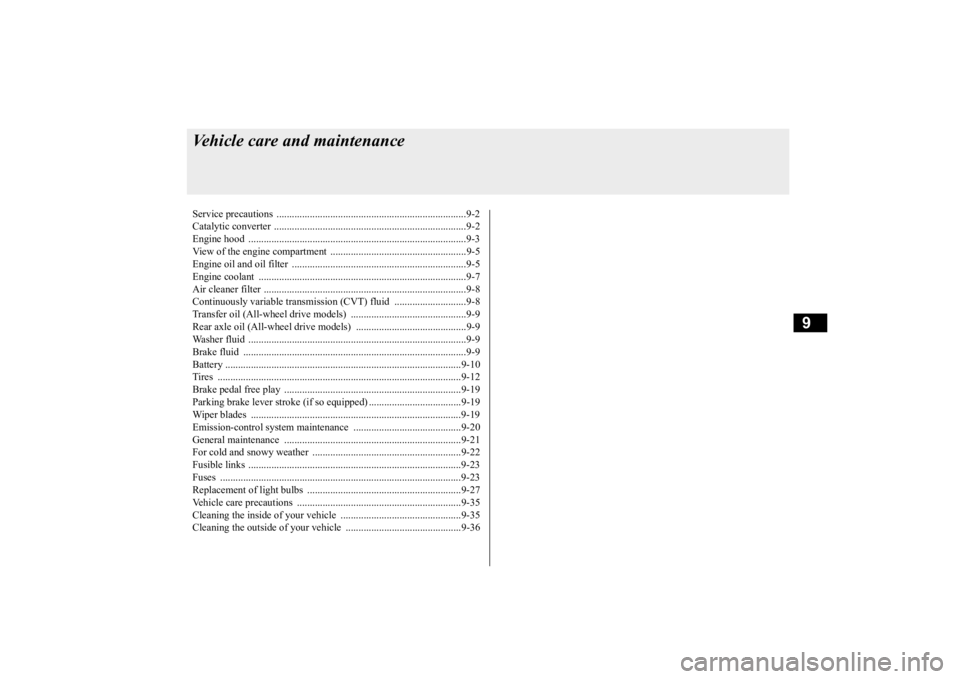
9
Vehicle care and maintenanceService precautions .........
.................................................................9-2
Catalytic converter
.................................................
..........................9-2
Engine hood ..............................
.......................................................9-3
View of the engine comp
artment .....................................................9-5
Engine oil and oil filt
er ................................
....................................9-5
Engine coolant ................
.................................................................9-7
Air cleaner filter ....
.................................................
..........................9-8
Continuously variable transmis
sion (CVT) fluid ............................9-8
Transfer oil (All-wheel dr
ive models) .............................................9-9
Rear axle oil (All-wheel dr
ive models) ...........................................9-9
Washer fluid ....................
.................................................................9-9
Brake fluid ......................
.................................................................9-9
Battery .......................................
.....................................................9-10
Tires ..........................................
.....................................................9-12
Brake pedal free play
.............................................
........................9-19
Parking brake lever stroke (if so equipped) ....................................9-19Wiper blades ...................
...............................................................9-19
Emission-control system maintenance ..........................................9-20 General maintenance
.............................................
........................9-21
For cold and snowy weat
her ..........................................................9-22
Fusible links ....................
...............................................................9-23
Fuses .........................................
.....................................................9-23
Replacement of light bu
lbs ............................................................9-27
Vehicle care precautions
........................................
........................9-35
Cleaning the inside of your
vehicle ...............................................9-35
Cleaning the outside of your
vehicle .............................................9-36
BK0277700US.bo
ok 1 ページ 2019年3月8日 金曜日 午前9時23分
Page 369 of 427
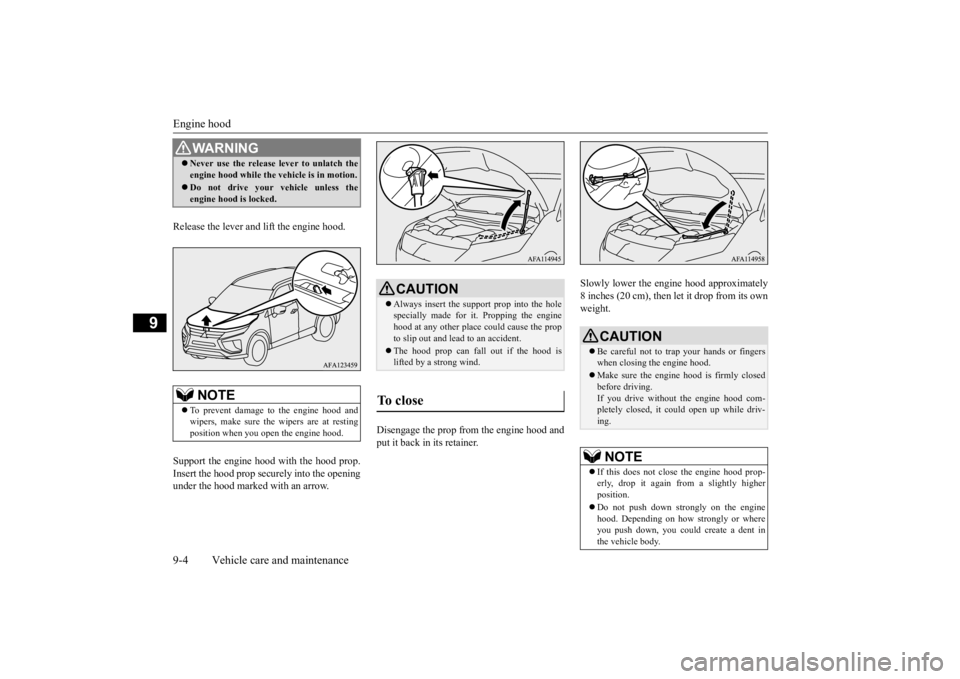
Engine hood 9-4 Vehicle care and maintenance
9
Release the lever and lift the engine hood. Support the engine hood with the hood prop. Insert the hood prop secu
rely into the opening
under the hood marked with an arrow.
Disengage the prop from the engine hood and put it back in its retainer.
Slowly lower the engine hood approximately 8 inches (20 cm), then let it drop from its ownweight.
WA R N I N G Never use the release lever to unlatch the engine hood while the vehicle is in motion. Do not drive your vehicle unless the engine hood is locked.NOTE
To prevent damage to the engine hood and wipers, make sure the wipers are at resting position when you open the engine hood.
CAUTION Always insert the support prop into the hole specially made for it. Propping the engine hood at any other place could cause the prop to slip out and lead to an accident. The hood prop can fall out if the hood is lifted by a strong wind.
To close
CAUTION Be careful not to trap your hands or fingers when closing the engine hood. Make sure the engine hood is firmly closed before driving. If you drive without the engine hood com-pletely closed, it could open up while driv- ing.NOTE
If this does not close the engine hood prop- erly, drop it again from a slightly higher position. Do not push down strongly on the engine hood. Depending on how strongly or where you push down, you could create a dent inthe vehicle body.
BK0277700US.bo
ok 4 ページ 2019年3月8日 金曜日 午前9時23分
Page 375 of 427
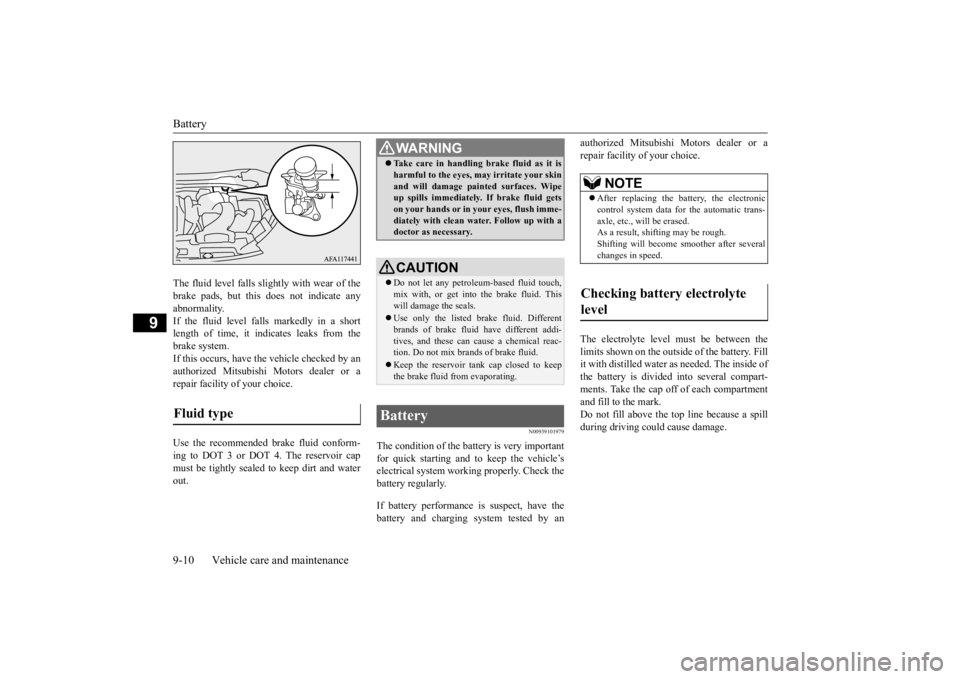
Battery 9-10 Vehicle care and maintenance
9
The fluid level falls slightly with wear of the brake pads, but this does not indicate anyabnormality. If the fluid level falls markedly in a short length of time, it indicates leaks from thebrake system. If this occurs, have the vehicle checked by an authorized Mitsubishi Motors dealer or arepair facility of your choice. Use the recommended brake fluid conform- ing to DOT 3 or DOT 4. The reservoir capmust be tightly sealed to keep dirt and water out.
N00939101979
The condition of the battery is very important for quick starting and to keep the vehicle’selectrical system working properly. Check the battery regularly. If battery performance is suspect, have the battery and charging system tested by an
authorized Mitsubishi Motors dealer or a repair facility of your choice. The electrolyte level must be between the limits shown on the outside of the battery. Fill it with distilled water as needed. The inside ofthe battery is divided into several compart- ments. Take the cap off of each compartment and fill to the mark.Do not fill above the top line because a spill during driving could cause damage.
Fluid type
WA R N I N G Take care in handling brake fluid as it is harmful to the eyes, may irritate your skin and will damage painted surfaces. Wipe up spills immediately. If brake fluid gets on your hands or in your eyes, flush imme-diately with clean water. Follow up with a doctor as necessary.CAUTION Do not let any petroleum-based fluid touch, mix with, or get into the brake fluid. This will damage the seals. Use only the listed brake fluid. Different brands of brake fluid have different addi- tives, and these can cause a chemical reac-tion. Do not mix brands of brake fluid. Keep the reservoir tank cap closed to keep the brake fluid from evaporating.
Battery
NOTE
After replacing the battery, the electronic control system data for the automatic trans- axle, etc., will be erased.As a result, shifting may be rough. Shifting will become smoother after several changes in speed.
Checking battery electrolyte level
BK0277700US.bo
ok 10 ページ 2019年3月8日 金曜日 午前9時23分
Page 377 of 427
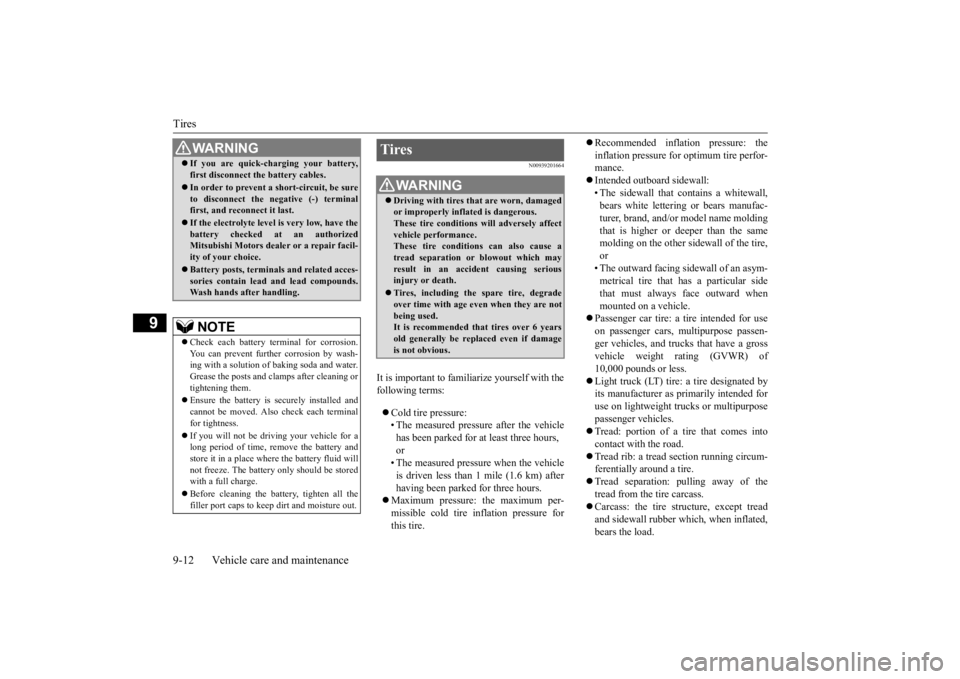
Tires 9-12 Vehicle care and maintenance
9
N00939201664
It is important to familiarize yourself with the following terms: Cold tire pressure: • The measured pressure after the vehicle has been parked for at least three hours,or • The measured pressure when the vehicle is driven less than 1 mile (1.6 km) afterhaving been parked for three hours.
Maximum pressure: the maximum per- missible cold tire inflation pressure forthis tire.
Recommended inflation pressure: the inflation pressure for optimum tire perfor- mance. Intended outboard sidewall: • The sidewall that contains a whitewall, bears white lettering or bears manufac- turer, brand, and/or model name moldingthat is higher or deeper than the same molding on the other sidewall of the tire, or• The outward facing sidewall of an asym-metrical tire that has a particular side that must always face outward when mounted on a vehicle.
Passenger car tire: a tire intended for use on passenger cars,
multipurpose passen-
ger vehicles, and trucks that have a grossvehicle weight rating (GVWR) of 10,000 pounds or less. Light truck (LT) tire: a tire designated by its manufacturer as primarily intended for use on lightweight trucks or multipurpose passenger vehicles. Tread: portion of a tire that comes into contact with the road. Tread rib: a tread section running circum- ferentially around a tire. Tread separation: pulling away of the tread from the tire carcass. Carcass: the tire structure, except tread and sidewall rubber which, when inflated, bears the load.
If you are quick-charging your battery, first disconnect the battery cables. In order to prevent a short-circuit, be sure to disconnect the negative (-) terminalfirst, and reconnect it last. If the electrolyte level is very low, have the battery checked at an authorized Mitsubishi Motors dealer or a repair facil- ity of your choice. Battery posts, terminals and related acces- sories contain lead and lead compounds.Wash hands after handling.NOTE
Check each battery terminal for corrosion. You can prevent further corrosion by wash- ing with a solution of baking soda and water.Grease the posts and clamps after cleaning or tightening them. Ensure the battery is securely installed and cannot be moved. Also check each terminal for tightness. If you will not be driv
ing your vehicle for a
long period of time, remove the battery and store it in a place where the battery fluid will not freeze. The battery only should be storedwith a full charge. Before cleaning the battery, tighten all the filler port caps to keep dirt and moisture out.WA R N I N G
Tires
WA R N I N G Driving with tires that are worn, damaged or improperly inflated is dangerous. These tire conditions will adversely affect vehicle performance.These tire conditions can also cause a tread separation or blowout which may result in an accident causing seriousinjury or death. Tires, including the spare tire, degrade over time with age even when they are not being used. It is recommended that tires over 6 yearsold generally be replaced even if damage is not obvious.
BK0277700US.bo
ok 12 ページ 2019年3月8日 金曜日 午前9時23分
Page 379 of 427

Tires 9-14 Vehicle care and maintenance
9
EXAMPLE: 95H
Maximum load indicates the maxi- mum load this tire is designed to carry.
Maximum Pressure indicates the maximum permissible cold tire infla- tion pressure for this tire. The TIN may be found on one or both sides of the tire but the date code may only be on one side. Look for the TIN on the outboard side of tires as mounted on the vehicle. If the TIN is not found on the outboard sidethen you will find it on the inboard side of the tire.
LT (Light Truck) -metric tiresizing is based on U.S.A. design standards. The size designationfor LT-metric tires is the same as for P-metric tires except for the letters “LT” that are molded intothe sidewall preceding the size designation. Example: LT235/85R16.Temporary spare tires are highpressure compact sparesdesigned for temporary emer- gency use only. Tires designed to this standard have the letter“T” molded into the sidewall preceding the size designation. Example: T145/80D18 103M.
Service Description 95
Load index A numerical code associated with the maximum load a tire can carry.NOTE
H
Speed symbol A symbol indicating the range of speeds at which a tire can carry a load corre-sponding to its load index under certain operating con- ditions.The maximum speed corre- sponding to the speed symbol should only be achieved under specified operating conditions. (i.e. tire pressure, vehicle loading, road condi-tions and posted speed limits)
Maximum Load
WA R N I N GOverloading of your tire is dangerous. Overloading can cause tire failure, affect vehi-cle handling, and increase your stopping distance. Use tires of the recommended loadcapacity for your vehicle. Never overload them.
Maximum Pressure Tire Identification Number (TIN)
BK0277700US.bo
ok 14 ページ 2019年3月8日 金曜日 午前9時23分
Page 385 of 427

Emission-control system maintenance 9-20 Vehicle care and maintenance
9
If the blades are frozen to the windshield or rear window, do not operate the wipers until the ice has melted and the blades are freed,otherwise the wiper motor may be damaged.
N00940800328
Your vehicle is equipped with an emission-control system that meets all the requirementsof the U.S. Environmental Protection Agency and Environment Canada. The emission-con- trol system is made of: a positive crankcase ventilation system an evaporative emission-control system an exhaust emission-control system
To be sure the emission-control system works properly, have your vehicle inspected and maintained by an authorized MitsubishiMotors dealer or a repair facility of your choice. This should be done at the time or mileage specified in the “WARRANTY ANDMAINTENANCE MANUAL”. These, and all the other “general” mainte- nance services listed in this manual, need tobe performed to keep your vehicle running properly and reliably. You should also have an inspection and ser-vice any time you suspect a malfunction.
N00940900231
Spark plugs must fire properly to ensureproper engine performance and emission-control. Do not reuse spark plugs by cleaning or regapping. Spark plugs should be replaced atthe mileage specified in the “WARRANTY AND MAINTENANCE MANUAL”.
CAUTION If the rear wiper is not stopped within the mark (A), the wiper arm will contact the roofspoiler and you will not be able to lift the wiper arm. If you forcefully try to lift the wiper arm, the wiper arm and roof spoilercould be damaged or the painted surfaces could be scratched.
During cold weather
Emission-control system maintenance
NOTE
To meet government regulations and pro- mote cleaner air, your vehicle is equipped with an onboard diagnostic system (OBD). The engine electronic control module that controls OBD functions stores various data(especially about the exhaust emissions). This data will be erased if the battery cable is disconnected, which could make a rapiddiagnosis difficult. Do not disconnect the battery cable when the engine malfunction indicator (“SERVICE ENGINE SOON” or“Check engine light”) is ON.
Spark plugs
NOTE
Use the recommended or equivalent spark plugs listed under “Engine specifications” on page 11-6. Use of other plugs could cause engine damage, loss of performance or radionoise.
BK0277700US.bo
ok 20 ページ 2019年3月8日 金曜日 午前9時23分
Page 387 of 427

For cold and snowy weather 9-22 Vehicle care and maintenance
9
N00941800093
Check the following parts for damage and grease leaks: Ball joint boots of the suspension and steering linkage Bellows on both ends of the drive shaft
N00942201118
The best way to keep carbon monoxide gas from entering inside your vehicle is to have the engine exhaust system properly serviced. Have a competent mechanic inspect the com-plete exhaust system and nearby body areas for broken, damaged, deteriorated, or mispo- sitioned parts if you notice any of the follow-ing: A change in the sound of the exhaust sys- tem The smell of exhaust fumes inside the vehicle
The underside or rear of the vehicle is damaged
Also check the exhaust system each time the vehicle is raised for lubrication, oil changes, or required service. Any open seams or looseconnections could let dangerous exhaust fumes seep into the luggage and passenger compartments. Check for holes or exhaust gas leaks caused by corrosion or damage. Check the joints and connections for looseness or exhaust gas leaks. Check the rubber hangers and brackets for damage.
N00942501124
The hood lock release mechanism and hood safety catch should be checked, cleaned, and oiled when needed for easy movement and toprevent rust and wear. Use Multipurpose Grease NLGI Grade 2 spar
ingly for all sliding
parts of the hood latch and release lever.Work the grease into the hood lock mecha-
nism until all the movable surfaces are cov- ered. Also, put a light coat of the same grease on the safety catch wherever moving parts touch.
N00942601141
The ventilation slots in front of the wind- shield should be brushed clear after a heavy snowfall so that the operation of the heatingand ventilation systems will not be impaired. To prevent freezing of the weatherstripping on the doors, engine hood, etc., they should be treated with silicone grease. It is a good idea to carry a shovel or a short- handled spade in the vehicle during the win- ter so that you can clear away snow if you get stranded. A small hand-brush for sweeping
Ball joint, steering linkage seals, drive shaft boots Exhaust system
WA R N I N G Carbon monoxide gas from your vehicle’s exhaust is poisonous. Breathing these fumes can cause unconsciousness or death.
Check for any of the following conditions: Hood lock release mechanism and safety catch
For cold and snowy weather Ventilation slots Weatherstripping Additional equipment (For regions where snow is encoun-tered)
BK0277700US.bo
ok 22 ページ 2019年3月8日 金曜日 午前9時23分
Page 389 of 427
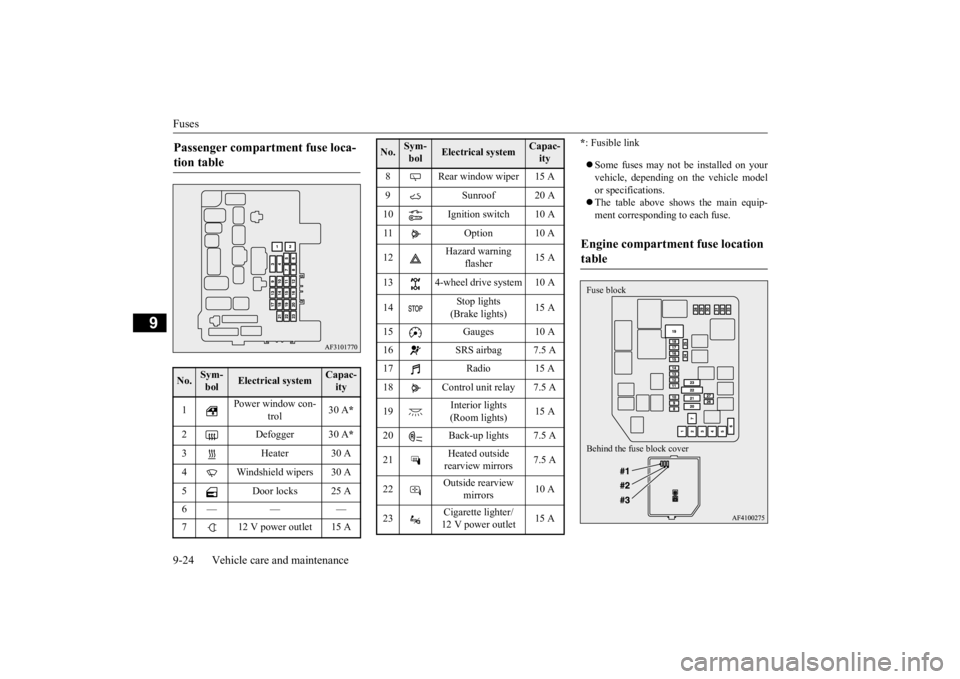
Fuses 9-24 Vehicle care and maintenance
9
* : Fusible link Some fuses may not be installed on your vehicle, depending on the vehicle model or specifications. The table above shows the main equip- ment corresponding to each fuse.
Passenger compartment fuse loca- tion table No.
Sym- bol
Electrical system
Capac-ity
1
Power window con-
trol
30 A
*
2 Defogger 30 A
*
3 Heater 30 A 4 Windshield wipers 30 A 5 Door locks 25 A 6— — — 7 12 V power outlet 15 A
8 Rear window wiper 15 A 9 Sunroof 20 A 10 Ignition switch 10 A 11 Option 10 A 12
Hazard warning
flasher
15 A
13 4-wheel drive system 10 A14
Stop lights (Brake lights)
15 A
15 Gauges 10 A 16 SRS airbag 7.5 A 17 Radio 15 A 18 Control unit relay 7.5 A 19
Interior lights (Room lights)
15 A
20 Back-up lights 7.5 A21
Heated outside rearview mirrors
7.5 A
22
Outside rearview
mirrors
10 A
23
Cigarette lighter/ 12 V power outlet
15 A
No.
Sym- bol
Electrical system
Capac-ity
Engine compartment fuse location table Behind the fuse block cover Fuse block
BK0277700US.bo
ok 24 ページ 2019年3月8日 金曜日 午前9時23分
Page 390 of 427
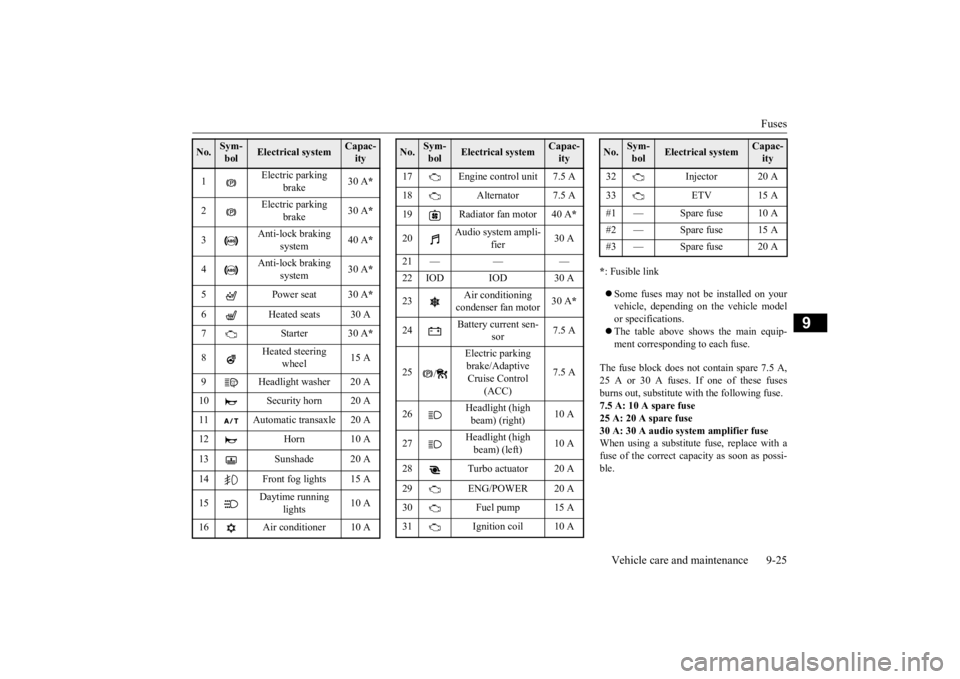
Fuses
Vehicle care and maintenance 9-25
9
* : Fusible link Some fuses may not be installed on your vehicle, depending on the vehicle model or specifications. The table above shows the main equip- ment corresponding to each fuse.
The fuse block does not contain spare 7.5 A, 25 A or 30 A fuses. If one of these fusesburns out, substitute with the following fuse.7.5 A: 10 A spare fuse 25 A: 20 A spare fuse 30 A: 30 A audio system amplifier fuseWhen using a substitute fuse, replace with a fuse of the correct capacity as soon as possi- ble.
No.
Sym- bol
Electrical system
Capac-ity
1
Electric parking
brake
30 A
*
2
Electric parking
brake
30 A
*
3
Anti-lock braking
system
40 A
*
4
Anti-lock braking
system
30 A
*
5 Power seat 30 A
*
6 Heated seats 30 A 7Starter30 A
*
8
Heated steering
wheel
15 A
9 Headlight washer 20 A 10 Security horn 20 A 11 Automatic transaxle 20 A 12 Horn 10 A 13 Sunshade 20 A14 Front fog lights 15 A 15
Daytime running
lights
10 A
16 Air conditioner 10 A
17 Engine control unit 7.5 A 18 Alternator 7.5 A 19 Radiator fan motor 40 A
*
20
Audio system ampli-
fier
30 A
21 — — — 22 IOD IOD 30 A 23
Air conditioning condenser fan motor
30 A
*
24
Battery current sen-
sor
7.5 A
25
/
Electric parking brake/Adaptive Cruise Control
(ACC)
7.5 A
26
Headlight (high beam) (right)
10 A
27
Headlight (high beam) (left)
10 A
28 Turbo actuator 20 A 29 ENG/POWER 20 A 30 Fuel pump 15 A31 Ignition coil 10 ANo.
Sym- bol
Electrical system
Capac-ity
32 Injector 20 A 33 ETV 15 A #1 — Spare fuse 10 A #2 — Spare fuse 15 A#3 — Spare fuse 20 ANo.
Sym- bol
Electrical system
Capac-ity
BK0277700US.bo
ok 25 ページ 2019年3月8日 金曜日 午前9時23分
Page 392 of 427
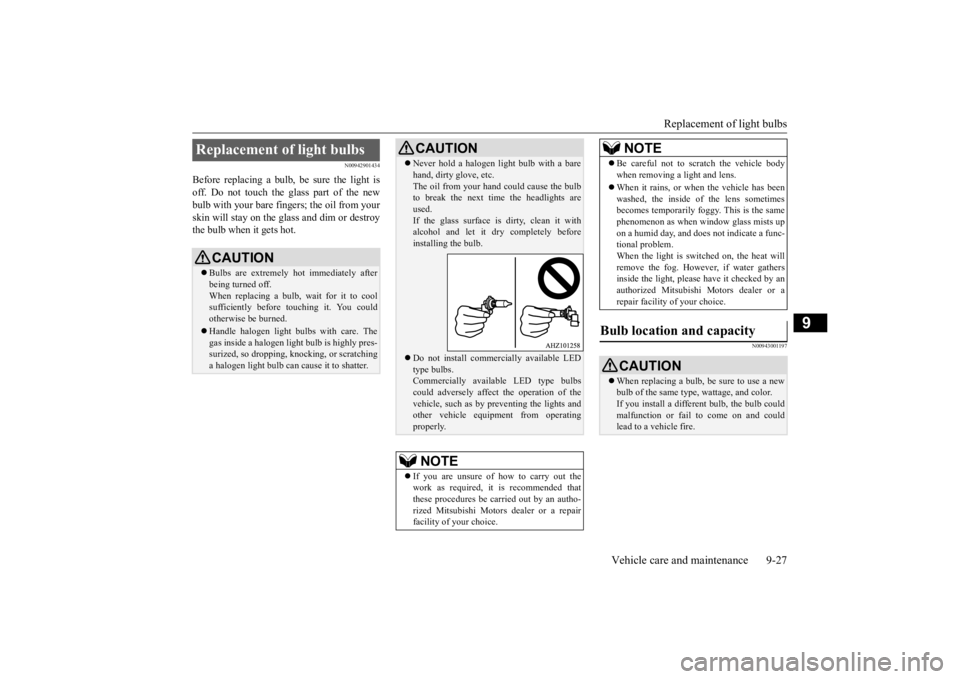
Replacement of light bulbs
Vehicle care and maintenance 9-27
9
N00942901434
Before replacing a bulb, be sure the light is off. Do not touch the glass part of the newbulb with your bare fingers; the oil from your skin will stay on the glass and dim or destroy the bulb when it gets hot.
N00943001197
Replacement of light bulbs
CAUTION Bulbs are extremely hot immediately after being turned off.When replacing a bulb, wait for it to cool sufficiently before touching it. You could otherwise be burned. Handle halogen light bulbs with care. The gas inside a halogen light bulb is highly pres-surized, so dropping, knocking, or scratching a halogen light bulb can cause it to shatter.
Never hold a halogen light bulb with a bare hand, dirty glove, etc. The oil from your hand could cause the bulb to break the next time the headlights are used.If the glass surface is dirty, clean it with alcohol and let it dry completely before installing the bulb. Do not install commercially available LED type bulbs.Commercially available LED type bulbs could adversely affect the operation of the vehicle, such as by preventing the lights andother vehicle equipment from operating properly.NOTE
If you are unsure of how to carry out the work as required, it is recommended that these procedures be carried out by an autho- rized Mitsubishi Motors dealer or a repairfacility of your choice.CAUTION
Be careful not to scratch the vehicle body when removing a light and lens. When it rains, or when the vehicle has been washed, the inside of the lens sometimesbecomes temporarily foggy. This is the same phenomenon as when window glass mists up on a humid day, and does not indicate a func-tional problem. When the light is switched on, the heat will remove the fog. However, if water gathersinside the light, please have it checked by an authorized Mitsubishi Motors dealer or a repair facility of your choice.
Bulb location and capacity
CAUTION When replacing a bulb, be sure to use a new bulb of the same type, wattage, and color.If you install a different bulb, the bulb could malfunction or fail to come on and could lead to a vehicle fire.NOTE
BK0277700US.bo
ok 27 ページ 2019年3月8日 金曜日 午前9時23分